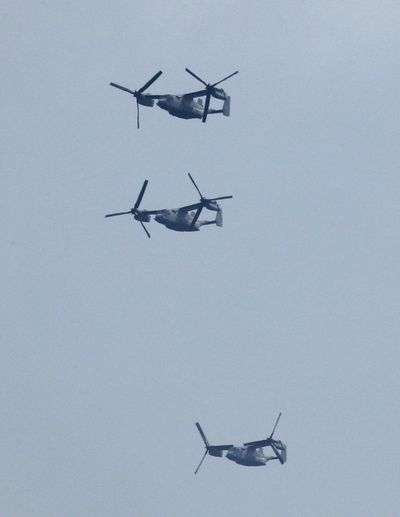Osprey proves its mettle in difficult Afghanistan
Tiltrotor aircraft handles harsh area

CAMP BASTION, Afghanistan – Almost four years after the MV-22 Osprey arrived in Afghanistan, trailing a reputation as dangerous and hard to maintain, the U.S. Marine Corps finally has had an opportunity to test the controversial hybrid aircraft in real war conditions. The reviews are startlingly positive.
“This is an ugly duckling that turned into a swan,” said Richard Whittle, the author of “The Dream Machine: The Untold History of the Notorious V-22 Osprey” and a senior scholar at the Wilson Center, a research center in Washington. “It is still probably more expensive than it should be, and more expensive to operate. But I think many people are still laboring under the impression that it is dangerous to fly, when it now has probably the best safety record of any rotorcraft that the military flies.”
The odd aircraft, which takes off and lands like a helicopter but rotates its engines forward to fly like an airplane, had a star-crossed development period that took more than two decades and included huge cost overruns and crashes that claimed 30 lives. Its deployment to Iraq’s Anbar province from 2007 to 2009, where as combat waned it was used mainly to transport people and cargo, won it criticism from the Government Accountability Office over maintenance and performance issues.
In Afghanistan, however, the Marines have been able to use it more widely, flying it for everything from freight to hundreds of assaults, where it’s carried loads of Marines into or out of landing zones, often under intense fire. It’s twice as fast as the helicopter it replaces, the CH-46, it has substantially greater range, and can carry more cargo and more than twice as many troops. The Marines are learning how to maintain it in a harsh environment.
Whittle, once an Osprey skeptic, has become a fan. “The Osprey has proven itself in Afghanistan in a way it didn’t in Iraq,” he said. “Partly that was because it didn’t get the chance in Iraq. Also, it was new, and the military is conservative with new equipment, but once they see it gives them a significant leap in capability like this, they are quick to take advantage of it.”
The MV-22 Ospreys here now are dusty, stained and smudged from hot exhaust, and at least five have returned to base with bullet holes, including – twice – the one flown by Lt. Col. Douglas Sanders, the commander of the Marine unit flying the Osprey in Afghanistan, Marine Medium Tiltrotor Squadron 264.
The various redundant systems work in the real world, said Maj. Matthew McSorley, a pilot and the operations officer for the squadron, who was hit by a different kind of fire while flying a mission on Valentine’s Day: a massive bolt of lightning.
“It was one of those days where the airplane itself just totally wins over your heart,” he said. “It bounced right back, and I flew it all the way back, and within a week I was flying the same plane again.”
Among the recent missions the squadron has flown was one in which the Osprey showed its strengths: A Marine with a head wound at a distant base needed to be moved to a second distant base for quick treatment.
The crew was alerted, dashed for the Osprey, spooled up the massive engines and zoomed north from Bastion some 40 miles. They picked up the wounded man and flew another 75 miles or so east to the massive coalition base in Kandahar, all in under an hour from the moment they got the call.
A conventional helicopter would have been hard-pressed to do the same, even without the 40-mile run from Bastion, Sanders said.
“With no prior notification, totally configured to do something else and, boom, just like that,” said Sanders, snapping his fingers. “That’s what the Osprey brings to the battlefield.”
The Osprey’s not officially designated as a medevac aircraft, but speed is everything when someone’s dying.
That sort of capability is among the many things the Marines have been learning about and getting used to, Whittle said.
A more typical use is taking advantage of the aircraft’s speed and range to hook around behind a target for an assault, coming in from an unexpected direction and circumventing the Taliban’s crude air-warning system.